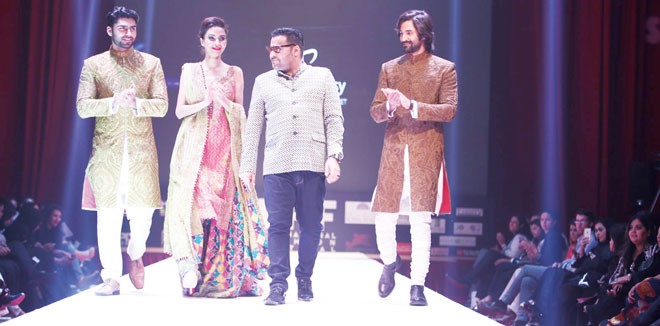
How do designers benefit from fashion shows held abroad, especially in regions where they have no retail presence? Instep poses the question

Every now and then, designers leave the trendsetting at home and venture abroad to score some sales. The ghararas and shararas from bridal week, the eastern prêt and occasionally the tops, pants and dresses from the seasonal collections make their way to foreign shores. The idea is to increase one’s brand’s exposure and boost its international market, but do those desired results materialize?
The recently held Qatar International Fashion Festival (QIFF) was one such fashion event that saw the likes of Adnan Pardesy and Asim Jofa show their collections in Doha. Did QIFF deliver its promise?
"I always go with no expectations," says Adnan Pardesy, who showed his latest bridal collection at QIFF this month, "But the response I got was fabulous. I think Doha’s a great market - it’s better than Dubai. Bridals offer a huge business in the Middle East and we got quite a few orders."
Sure enough, regions like the Middle East and India are likely to be more receptive to Pakistani fashion, but what about Europe and America where designers also frequently show? While small capsules in the desi incarnations of fashion shows in the West may see Pakistani designers reach out to the Indian Asian clientele in those countries, Pakistan is not ready to compete in the Western market. Buyers there have the pick of the best retail stores for Western prêt.
"Paris and Amsterdam were just shows," Pardesy admits about his earlier showings in Europe, "but you never know who you might meet after the show. There are people who just come to watch the show and then there are serious buyers. They add to our existing online clientele in India and the Middle East."
It’s hard to ignore the Middle East as a lucrative market. In the words of HSY, "we have the same culture, religion and weather as the Middle East, and thus the same requirements." He adds, "There’s no point in showing in a place where you have no market and nothing to financially gain. While designers should show abroad for the projection of their brand, some just go for the ser sapata and don’t follow up. You have to talk to stores and look for business prospects in order to generate business abroad."
The idea of the necessity of international exposure is echoed by Deepak Perwani, who has shown from Miami to Malaysia, but he is circumspect about whether the focus on the conversation should even be on the international market. While he admits that the only way deals are struck if people know what your brand is, what’s more important at the moment is to focus on our capability to consistently deliver.
"As far as international markets are concerned, I believe that the more international exposure you have, the more doors open for your brand," says Perwani, whose recent Bulgarian Fashion Award nomination was the result of the international exposure his brand has enjoted in the past and his subsequent victory will pave the way for several more showings across Europe in the years to come.
"We’re still trying to develop fashion and retail in Pakistan. When buyers come to Pakistan, they’re looking for consistency of design and production lines, the ability to meet their timelines. So for both parties, the exercise is meaningless if designers are simply not able to deliver. Countries like China and Bangladesh are way ahead of us of in terms of finishing, etc."
While there’s no denying that the fashion industry is young - it’s only a decade ago that fashion only became regulated with season-wise collections, Deepak says - it is no short of beneficial opportunities locally.
Our biggest textile mills have now opened stores, while foreign retail giants are investing in Pakistan - it shows that the retail presence in Pakistan is huge.
"An Indian designer once told me that there are 300 multibrand stores in India alone, so the market there is huge," shares Perwani, "They don’t need to bother about foreign timelines and requirements." It makes one wonder whether Pakistan should follow suit?
Of course, if nothing else, there is the softer image of Pakistan that designers talk about. And Perwani doesn’t disagree. "Wherever we go abroad, we are ambassadors of Pakistan because so little is known about us. We are like shining beacons of light. When we show our clothes, perceptions change. People are shocked to know that our collections are coming from Pakistan."